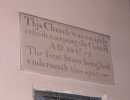For this church:    |
Beeston St John the BaptistFeatures and FittingsChancel
|
 The
sedilia The
sedilia |
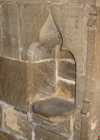 The
piscina The
piscina |
Sedilia & Piscina
The chancel has a piscina and carved and canopied triple sedilia, the latter dating from the medieval church. The sedilia originally had ‘crockets’ - carved buds or curled leaves, and finials outlining cinquefoil heads which have been chipped away.
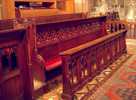 Choir
stalls
Choir
stalls
Memorial choir stalls were erected in 1875 to the memory of J.Fellows, Esq, of Beeston Fields.
 Altar
and Reredos
Altar
and Reredos
The carved stone reredos depicting the Last Supper was presented by C.F.Fellows, Esq. and dedicated on Trinity Sunday, 1880.
Nave
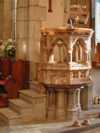 Pulpit
Pulpit
The Nottingham alabaster pulpit was erected in memory of Rev T.J.Oldrini, vicar from 1854-85.
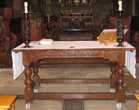 Communion
Table
Communion
Table
The Communion Table, now in the nave, is Elizabethan and may originally have stood in the chancel.
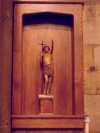 Statue
of Statue
ofJohn the Baptist |
 Statue
of the Statue
of theVirgin and Child |
Statues
The statue of St John the Baptist is in a niche to the north of the chancel arch was given by the Guild of Servers in 1927. The cases in which stand this statue and that of the Madonna and Child were made by Mr Dennis Scott.
The statue of the Madonna and Child is in the niche to the south of the chancel arch.
 Alms Box
Alms Box
Next to the back of a pew near to the entrance is a wooden alms box on a pillar. It is inscribed:
| WA EB C W 1684 |
Presumably this indicates that “WA” and “EB” were the churchwardens in that particular year.
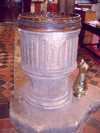 Font
Font
The upper part of an Early Norman font was discovered under the Communion table and set on a new base. It was believed to have been made during the reign of Henry III (1216-72). It is now situated at the rear of the church.
A pointed lid used to be suspended from the roof, but is now in the belfry. The present cover was carved by Mr R Shaw, a former churchwarden, and is inscribed ‘John did baptize in the wilderness and preach the baptism of repentance for the remission of sins.’
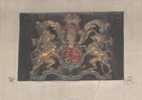 Royal Coat of Arms
Royal Coat of Arms
This, as at one stage was expected to be displayed in all churches, can be seen over the west door.
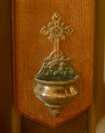 The
holy water stoup The
holy water stoup |
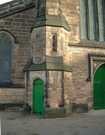 North-west
stair North-west
stairseen from the outside |
 North-west
stair North-west
stairfrom within the nave, showing the blocked upper end |
Other items
There is a holy water stoup on a pillar
To the left of the main west door is a small door, which led to a gallery to accommodate the choir and organ. The staircase remains, but the doorway at the top is blocked.
Porch
Plaques
There are a number of plaques on the walls of the porch by the south door.
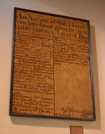 On
the west wall is a Board of Account of what donations have been given by charitable
persons to the poor of Beeston 1724. This was restored 1991 through bequest
by Edith Sanders 1896-1989 and Elsie Sanders 1898-1990.
On
the west wall is a Board of Account of what donations have been given by charitable
persons to the poor of Beeston 1724. This was restored 1991 through bequest
by Edith Sanders 1896-1989 and Elsie Sanders 1898-1990.
 On
the north wall, above the door into the nave:
On
the north wall, above the door into the nave:
This Church was rebuilt excepting the Chancel, with about 550 additional Sittings by Private Subscriptions, aided by Grants from the Nottinghamshire and Incorporated Church building Societies, and Reconsecrated 5th September 1844. The whole of the Seats in this Church are Free and Unappropriated for ever.
|
| The church was entirely rebuilt excepting the chancel AD 1843-44. The first stone being laid underneath this spot |
Another stone is inscribed:
| The first stone of the new building was laid by Mary Wolley |
Other Items
Bibles
Two Black Letter Bibles (so called because of their style of printing) were found in the belfry in 1902, neither being complete. They were restored under the supervision of Rev A C Beckton by Mr John Caster, a Beeston bookbinder, the repairs being funded by Mr C Fellows. They were stored for many years in a glass case, before being removed in 1991 to the care of the Hallward Library, University of Nottingham. Pages torn from the Bibles were used to pack fragments of the stained glass formerly in the church before its restoration in 1842-4.
One is the first edition of the Authorised Version, 1611, issued under James I. This copy is known as the ‘He’ Bible because of an error in Ruth 3.15, where the text reads ‘He went into the city’ instead of ‘She ...’. The 1631 edition, sometimes referred to as the ‘She’ Bible, has most of the errors corrected except for two in Ezekiel, but a further error had crept in: this edition added a list of books of the bible, and in doing so listed I and II Chronicles as I and II Corinthians



